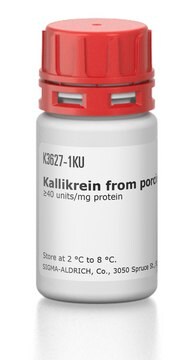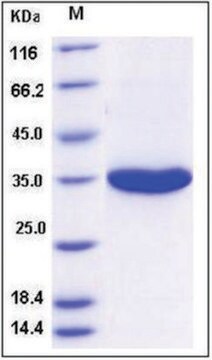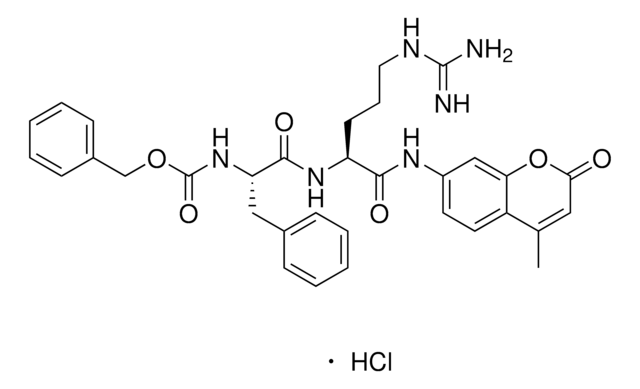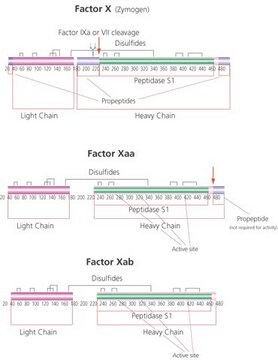Wszystkie zdjęcia(1)
Kluczowe dokumenty
K2638
Kallikrein from human plasma
buffered aqueous solution, ≥5 units/mg protein
Synonim(y):
Kininogenase, Kininogenin
Zaloguj sięWyświetlanie cen organizacyjnych i kontraktowych
About This Item
Numer CAS:
Numer MDL:
Kod UNSPSC:
12352204
NACRES:
NA.54
Polecane produkty
Formularz
buffered aqueous solution
Poziom jakości
aktywność właściwa
≥5 units/mg protein
numer dostępu UniProt
Warunki transportu
dry ice
temp. przechowywania
−20°C
informacje o genach
human ... KLK1(3816)
Szukasz podobnych produktów? Odwiedź Przewodnik dotyczący porównywania produktów
Opis ogólny
Kallikrein-related peptidases belong to the family of 15 highly conserved trypsin- or chymotrypsin-like serine proteases. Plasma kallikrein (PK) is a serine protease derived from plasma prekallikrein, a zymogen found at higher levels in blood circulation. The KLKB1 gene is located on the human chromosome at 4q35.2.
Zastosowanie
Kallikrein from human plasma has been used:
- to culture human hepatocellular carcinoma cell line
- to study its effects on the cleavage of Neisserial heparin binding antigen (NHBA) from Neisseria meningitidis
- in peptidase inhibition assay
Działania biochem./fizjol.
Plasma kallikrein (PK) is involved in the synthesis of bradykinin, maintaining the blood metabolite levels and hypertension. It also participates in the activation of coagulation factor XII, which promotes inflammation and the intrinsic coagulation pathway. PK controls proteolytic cascades in the cardiovascular system like the kallikrein-kinin system, renin-angiotensin system, fibrinolytic system, and the alternative complement pathway. It is involved in the cleavage of glucagon-like peptide-1 (GLP-1) and neuropeptide Y (NPY) which suggests that plasma kallikrein may affect metabolism and diabetes.
Definicja jednostki
One unit will hydrolyze 1.0 μmole of Nα-benzoyl-L-arginine ethyl ester (BAEE) to Nα-benzoyl-L-arginine and ethanol per min at pH 8.7 at 25°C.
Postać fizyczna
Solution in 20 mM Tris-HCl, pH 7.8 with 100 mM NaCl.
Ta strona może zawierać tekst przetłumaczony maszynowo.
Kod klasy składowania
12 - Non Combustible Liquids
Klasa zagrożenia wodnego (WGK)
WGK 1
Temperatura zapłonu (°F)
Not applicable
Temperatura zapłonu (°C)
Not applicable
Środki ochrony indywidualnej
Eyeshields, Gloves, multi-purpose combination respirator cartridge (US)
Wybierz jedną z najnowszych wersji:
Masz już ten produkt?
Dokumenty związane z niedawno zakupionymi produktami zostały zamieszczone w Bibliotece dokumentów.
Klienci oglądali również te produkty
Xueqing Xu et al.
Nucleic acids research, 37(22), 7381-7393 (2009-10-13)
A subtelomeric region, 4q35.2, is implicated in facioscapulohumeral muscular dystrophy (FSHD), a dominant disease thought to involve local pathogenic changes in chromatin. FSHD patients have too few copies of a tandem 3.3-kb repeat (D4Z4) at 4q35.2. No phenotype is associated
Elisa Pantano et al.
PloS one, 14(8), e0203234-e0203234 (2019-08-02)
Neisserial Heparin Binding Antigen (NHBA) is a surface-exposed lipoprotein of Neisseria meningitidis and a component of the Bexsero vaccine. NHBA is characterized by the presence of a highly conserved Arg-rich region involved in binding to heparin and heparan sulphate proteoglycans
H Austin et al.
Journal of thrombosis and haemostasis : JTH, 9(3), 489-495 (2011-01-15)
We evaluated 10 single-nucleotide polymorphisms (SNPs) identified in three European case-control studies as risk factors for venous thrombosis. We sought to replicate the positive findings from this report among Whites and to evaluate the association of these SNPs with venous
L E Stolz et al.
Drugs of today (Barcelona, Spain : 1998), 46(8), 547-555 (2010-09-11)
Hereditary angioedema (HAE) is a debilitating, potentially fatal disease characterized by variable and unpredictable acute attacks of swelling affecting the subcutaneous tissue and mucosa. It is an autosomal dominant disorder resulting from a genetic deficiency of functional C1-esterase inhibitor. Available
A new case of homozygous C1-inhibitor deficiency suggests a role for Arg378 in the control of kinin pathway activation.
Alberto López-Lera et al.
The Journal of allergy and clinical immunology, 126(6), 1307-1310 (2010-09-25)
Nasz zespół naukowców ma doświadczenie we wszystkich obszarach badań, w tym w naukach przyrodniczych, materiałoznawstwie, syntezie chemicznej, chromatografii, analityce i wielu innych dziedzinach.
Skontaktuj się z zespołem ds. pomocy technicznej












